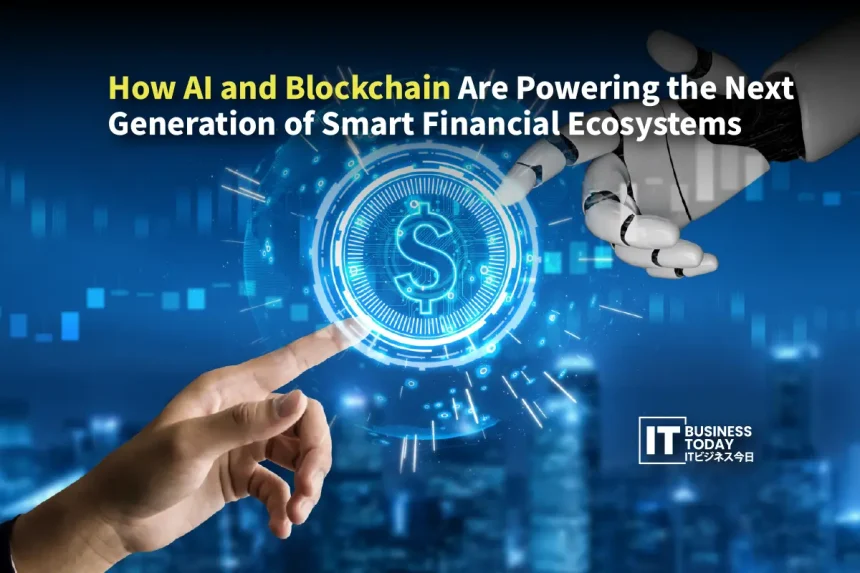The pace of digital change in finance is moving so quickly that the old foundations barely have time to settle before the next wave arrives. The traditional financial backbone is being replaced by a nervous system built on code, one that reacts, learns and verifies in real time. At the center of this change sit two technologies that used to live in separate conversations. AI provides the intelligence that analyzes patterns, automates decisions and adapts to new risks. Blockchain provides the trust layer that keeps records tamper proof and agreements transparent.
Put them together and the picture becomes much bigger than either technology on its own. They form the building blocks of a new class of smart financial ecosystems that run faster, stay more secure and include more people by design. That is the real shift taking shape. It is not just digital transformation. It is the reinvention of financial infrastructure itself.
The Expertise Pillar where AI becomes the engine of intelligence
AI has quietly become the brain behind modern finance. Not the flashy sci-fi stuff people love to hype but the real muscles that move decisions, shape offers and filter risks before humans even notice something changed. When you zoom into how this shift happened the answer is almost boring in its inevitability. Banks sit on oceans of data and anything that learns from patterns will eventually outperform humans who mostly rely on instinct, habit and overworked dashboards.
Also Read: Deepfake Defence in Japan: How Corporates Are Battling AI-Driven Social Engineering in a Low-Birth-Rate Economy
This becomes obvious the moment you look at personalization. Predictive models comb through spending trails, income flows and behavioral signals to guess what a customer actually needs instead of what a product team wants to sell. Robo advisors run simulations in seconds. Lending engines adjust terms with a level of nuance that would take analysts hours. The upside is a smoother experience where customers feel like the bank finally gets them instead of throwing random offers at them.
Then comes the security story which honestly carries the heaviest weight. Real time streams are too fast and too complex for rule based systems. Deep learning models read them like a language and catch the weird stuff before it becomes a headline. That is why so many institutions reported massive jumps in security performance. Eighty-one percent saw better threat identification. Seventy-nine percent improved threat intelligence and response. Sixty-six percent cut the time it takes to resolve issues. These are not soft wins. These are core system wins.
And while everyone debates the future AI quietly handles the grunt work too. Back office tasks shrink. Reconciliation smoothens out. Credit scoring runs faster. No surprise that fifty-three percent of financial services executives say they already use AI agents in production. Adoption is no longer a future plan. It is the new floor.
Blockchain as the Foundation of Trust and Transparency

If AI is the brain of modern finance, then blockchain is the spine that holds everything steady. You can build all the intelligence you want but if the underlying data can be altered or questioned the whole system collapses. That is why the idea of an immutable, decentralized ledger hits so hard in financial environments. When every record is locked through cryptographic proofs and distributed across nodes, tampering stops being a possibility and becomes a mathematical impossibility. Banks finally get a data layer they can trust without relying on blind faith or a single point of control.
Once this foundation is in place the automation story opens up. Smart contracts take rules that usually sit in PDF documents, email chains or compliance manuals and turn them into self-executing code. Settlements run on their own. Derivatives clear with precise conditions. Trade finance stops drowning in paperwork. Everything moves with a clarity that traditional workflows simply cannot deliver. It also removes the classic middle layers that slow down transactions, raise fees and create room for interpretation. Code becomes the final referee and everyone plays by the same rules.
The identity problem is the next big unlock. Financial institutions spend an absurd amount of time and money verifying customers again and again even when those users already completed KYC at another bank. Blockchain finally lets identity behave like a reusable asset. A verified digital identity sits on a secure shared network and any authorized institution can check it without repeating the entire process. This cuts onboarding time, reduces fraud and gives customers a smoother path into the system. It also tightens AML work because every verification step leaves a traceable audit trail.
The Synergy Where AI and Blockchain Converge Smart Ecosystems
This is the part where the story stops running on separate tracks and everything starts to click together. AI builds intelligence. Blockchain builds trust. Put them side by side and you get systems that not only run faster but also make better decisions with cleaner data and fewer intermediaries. It feels like finance is slowly shifting from a patchwork of tools to an actual ecosystem that learns, verifies and executes with almost no friction.
You can see this most clearly in the way tokenization is picking up momentum. Blockchain gives assets a digital wrapper so they can be divided, traded and settled with ease. Then AI steps in as the strategist that prices those assets, predicts liquidity demands and models risk with more nuance than any spreadsheet could pull off. This combination is not theory anymore. Deloitte predicts the tokenized real estate market will jump from under three hundred billion dollars in 2024 to four trillion by 2035. That scale does not happen unless smarter modeling and reliable digital infrastructure work together. Tokenization becomes more than a tech demo. It becomes a financial engine.
The regulatory side is shifting just as quickly. Compliance teams have always had to chase events after they happened. AI breaks that pattern by watching blockchain data in real time and flagging anything that smells off before it snowballs. Every check leaves an immutable record which removes the usual back and forth about who approved what and when. It turns audits into a pull of verified data instead of a scramble for scattered files. For regulators and institutions this is the first real step toward compliance that feels proactive instead of burdensome.
The DeFi world pushes this further. Most lending protocols still lean heavily on collateral because they cannot judge creditworthiness. AI changes that. By reading on chain behavior, wallet histories and transactional patterns, models can build a more complete risk profile of a user. This opens the door to smarter lending instead of the one size fits all collateral rules that dominate today. According to the AWS Banking on the Cloud 2025 report, banks are already experimenting with agentic workflows where AI agents’ complete tasks autonomously. The same idea naturally extends into DeFi once you give those agents.
Challenges, Trustworthiness, and the Future Outlook
Even with all the momentum behind AI and blockchain the road ahead is not a clean runway. The first big challenge shows up in scalability. As AI systems begin to trigger thousands of micro decisions per second the underlying blockchain networks need to handle that load without slowing down. If the base layer cannot keep up the entire smart ecosystem starts to feel clogged. The second challenge is regulatory uncertainty. Policymakers are still trying to understand decentralized systems while AI evolves faster than their playbooks. This mismatch creates hesitation for banks that want to innovate but fear stepping outside a rule that might appear later. The third challenge is ethical AI. Models that shape lending decisions must stay fair and transparent or they risk silently baking bias into the system.
Yet the upside is too large to ignore. Accenture estimates that banks which modernize using digital twins with cloud and AI can reach up to sixty percent higher revenue growth and nearly forty percent higher profit. These numbers make it clear that the institutions willing to push through the friction stand to gain the most.
Trust becomes the final piece. People need to understand how the intelligence works. That is where explainable AI steps in. At the same time many blockchain networks operate openly which lets anyone inspect how data flows. Put these together and you get a foundation that feels accountable instead of mysterious.
The Roadmap to the Future of Finance

If you zoom out from all the moving pieces the picture becomes pretty clear. AI brings the intelligence that predicts, personalizes and secures. Blockchain brings the trust layer that locks data, automates agreements and keeps everyone honest. Together they form the kind of financial ecosystem that runs faster, costs less to operate and gives users a level of transparency they never had before. This is not a distant future. It is already unfolding in the background while most institutions are still debating policy decks and legacy risks.
The choice now is simple. Traditional players can upgrade their systems, rethink how they build trust and start using these tools as core infrastructure or they can hope the old model somehow survives the next decade. The market is not waiting. Customers are not waiting. And the institutions that lean into AI and blockchain early will shape the rules everyone else follows.






